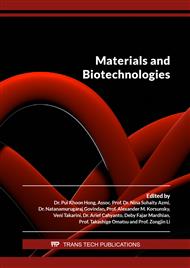[1]
IPCC (2014) Climate Change 2014: Synthesis Report. Contribution of Working Groups I, II and III to the Fifth Assessment Report of the Intergovernmental Panel on Climate Change. Edited by Core Writing Team, R. K. Pachauri, and L. Meyer. Geneva, Switzerland.
DOI: 10.1017/cbo9781107415416
Google Scholar
[2]
Philippine Statistics Authority (2018) Land Asset Accounts for Tree-Covered Areas of the Philippines. Quezon City, Philippines.
Google Scholar
[3]
Zheng, Y. et al. (2014) 'Pretreatment of lignocellulosic biomass for enhanced biogas production', Progress in Energy and Combustion Science. Elsevier Ltd, 42, p.35–53.
DOI: 10.1016/j.pecs.2014.01.001
Google Scholar
[4]
Kumar, P. et al. (2009) 'Methods for Pretreatment of Lignocellulosic Biomass for Efficient Hydrolysis and Biofuel Production Methods for Pretreatment of Lignocellulosic Biomass for Efficient Hydrolysis and Biofuel Production', Industrial & Engineering Chemistry Research, 4(8), p.21678–21684.
DOI: 10.1021/ie801542g
Google Scholar
[5]
Rivadeneira, J. P., Flavier, M. E. and Nayve, F. R. P. (2019) 'Optimization of acid and steam explosion pretreatment of cogon grass for improved cellulose enzymatic saccharification', Eurasian Chemico-Technological Journal, 21, p.143–147.
DOI: 10.18321/ectj824
Google Scholar
[6]
Somogyi, M. (1952) 'Notes on sugar determination', The Journal of Biological Chemistry, 195, p.19–24.
Google Scholar
[7]
Buranov, A. U. and Mazza, G. (2008) 'Lignin in straw of herbaceous crops', Industrial Crops and Products, 28, p.237–259.
DOI: 10.1016/j.indcrop.2008.03.008
Google Scholar
[8]
Bruice, P. Y. (2004) Organic Chemistry. 4th edn. Upper Saddle River, N.J.: Prentice Hall.
Google Scholar
[9]
Modenbach, A. A. and Nokes, S. E. (2014) 'Effects of Sodium Hydroxide Pretreatment on Structural Components of Biomass', Advances in Biomass Pretreatment and Conversion, 57(4), p.1187–1198.
DOI: 10.13031/trans.57.10046
Google Scholar
[10]
Modenbach, A. A., Nokes, S. E. (2014) 'Effects of sodium hydroxide pretreatment on structural components of biomass', American Society of Agricultural and Biological Engineers, 57 (4), pp.1187-1198
DOI: 10.13031/trans.57.10046
Google Scholar
[11]
Bensah, E. C., Mensah, M. (2013), 'Chemical pretreatment methods for the production of cellulosic ethanol: Technologies and innovations', International Journal of Chemical Engineering, ID 719607
DOI: 10.1155/2013/719607
Google Scholar
[12]
Salehian, P., Karimi, K. (2013), Alkali pretreatment for improvement of biogas and ethanol production from different waste parts of pine tree, Industrial and Engineering Chemistry Research, 52, pp.972-978
DOI: 10.1021/ie302805c
Google Scholar
[13]
Pielhop, T. et al. (2016) 'Biotechnology for Biofuels Steam explosion pretreatment of softwood: the effect of the explosive decompression on enzymatic digestibility', Biotechnology for Biofuels. BioMed Central, 9(152), p.1–13.
DOI: 10.1186/s13068-016-0567-1
Google Scholar
[14]
Jacquet, N. et al. (2015) 'Application of Steam Explosion as Pretreatment on Lignocellulosic Material: A Review', Industrial & Engineering Chemistry Research, 54(10), p.2593–2598.
DOI: 10.1021/ie503151g
Google Scholar
[15]
Lam, P.S. et al. (2011) 'Energy Input and Quality of Pellets Made from Steam-Exploded Douglas Fir (Pseudotsuga menziesii)', Energy Fuels, 25(4), p.1521–1528.
DOI: 10.1021/ef101683s
Google Scholar
[16]
Grous, W.R., Converse, A.O. and Grethlein, H.E. (1986) 'Effect of steam explosion pretreatment on pore size and enzymatic hydrolysis of poplar', Enzyme and Microbial Technology, 8(5), p.274–280.
DOI: 10.1016/0141-0229(86)90021-9
Google Scholar



